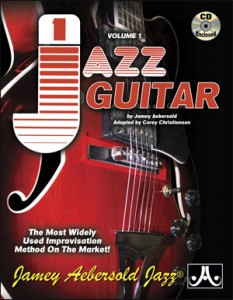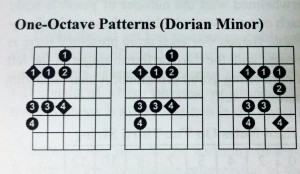As with any good story, this one starts at the beginning. Specifically, Volume 1 for Jazz Guitar. This book was written by Jamey Aebersold and was adapted for the guitar by Corey Christiansen. It incorporates guitar diagrams and tablature as well as standard musical notation.
I have been a musician and played guitar for some time now, but I have yet to wade into the deep and treacherous waters (or so they seemed to me!) of jazz guitar. That is, until now. I have always loved the sound of a good jazz box guitar and great players like Django Rheinhardt, Tal Farlow, and Wes Montgomery. Like many musicians and guitarists, the tunes, the modes, the seemly frantic playing, all intimidated me. Could I learn how to play like these men? It seemed so foreign to me! However, the introduction of this book immediately contradicts this presumption.
I have never met a person who couldn’t improvise! I’ve met many who think they can’t. Your mind is the builder and what you think… you become. A positive mental attitude contributes to much successful improvisation.
Practice and Learning
There are many practicing and learning techniques that are suggested to help in mastering the material presented in this book. All of the techniques could be applied to any instrument, tune, or playing technique that one wished to learn. Jamey’s points for learning to improvise and play jazz are:
- Desire to improvise
- Listening to jazz via recordings and live performances
- A method of practice – what and how to practice
- A rhythm section with which to practice and improvise
- Self-esteem and discipline
This volume with two play-a-long CDs (one is regular tempo with examples played by Corey Christiansen, the second is a slower tempo to play along with until you can play the examples at full speed) is designed to help a player with the development of all these skills and more.
The examples and text are filled with little nuggets of musical wisdom, such as;
The principle is always the same… know the scales and chords to the harmony of each tune or musical track; keep your place and play from your musical mind when you improvise
As well as humorous aphorisms like;
Music is not meant to be complicated (but musicians may be!)
Finally, we get to guitar specific diagrams. These first diagrams show movable scale shapes in both one and two octaves for the Major scale, Dorian Minor, and Mixolydian. These scale shapes make up the majority of the first exercises in the book, and indeed, are the most commonly used by beginning jazz improvisors. These examples are played in three keys, F, Eb, and D.
The First Exercise
As I worked through the first exercises using the Dorian Minor scale, I started to noodle with the scale shape presented in the first few. Fortunately for me, I was already familiar with the Dorian Minor scale shape used in the first examples. Unfortunately for me, because I already had this head start, I wanted to rush through the examples I could play without truly absorbing the information given there. However, when I went back to play with the recording, I was stumbling all over myself, losing my place, and getting flustered! So, to give myself a break from frustrating myself, I flipped back through the first pages, and I see something that I had already read, but clearly not taken to heart:
READ THIS FIRST
This book contains much information. It’s not intended that you race through it. Take your time and feel good about absorbing the material and ideas I am presenting. It has taken years to garner the knowledge with you hold in your hands. Don’t expect to assimilate and digest it overnight
This sobering lesson may be one of the best in music. It is so simple, and because it is so simple, it often gets overlooked. I am not proud of forgetting this maxim, but it is better that I am reminded of it now rather down the road on my foray into jazz guitar. Learning anything, not just music, takes time. Sure, there are a few players who are naturally talented. But if they don’t practice and take time to learn new things, in a short amount of time, talent is surpassed by learned, practiced, and hard earned skill.
I’m looking forward to continuing to delve into this volume for jazz guitar! Please check back for updates as I continue to work through this book. With that in mind, I’m going to get back to practicing!
One…two… a one, two, three, four!

